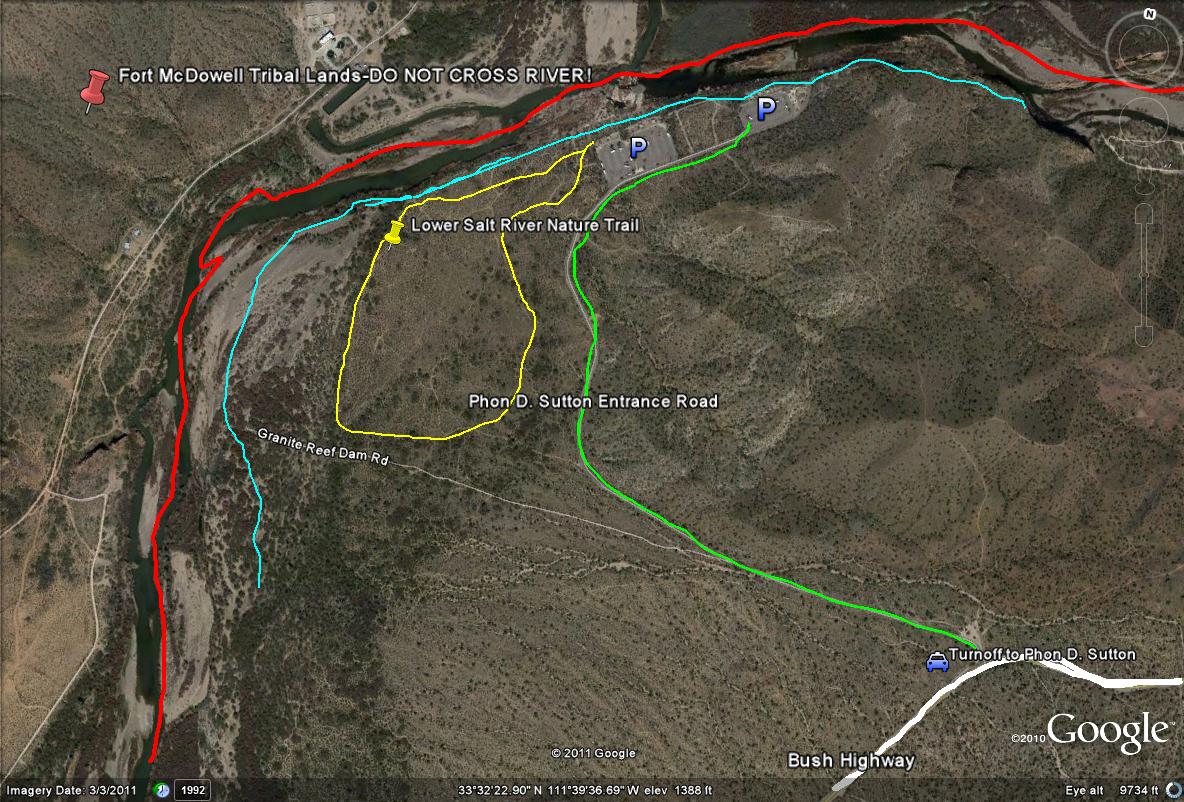Phon D. Sutton Recreation Site
Fast Flight Facts
Target Species: Desert Riparian bird species
Elevation: 1400'
Habitat: Desert Riparian Habitat along the confluence of the Salt and Verde Rivers
Overall Birding Rating: 4
Difficulty: 2 (Fairly easy)
Birding Type: Moderate Hiking
Facilities: Parking, restrooms, trailer hookups, camping
Fees/Ownership: Six dollar Tonto National Forest Fee
Closest Town or City/How far from Phoenix: Mesa/25 miles east-northeast of Phoenix
Getting there: Accessed from road that leads a short distance to the recreation site from the Bush Highway
Overview: The Phon D. Sutton Recreation Site is the second recreation site stop along the Bush Highway, and certainly one of the better sites to bird at. It is a very nice area both habitat and bird-wise with good diversity. Dense willows and cottonwood stands line the Salt River at this site, especially at the west end. Here at Phon D. Sutton is where the confluence of the Salt and Verde Rivers meet. Good desert habitat is the main fill when driving up on the entrance road and the surrounding area away from the immediate parts of the Salt River. A nature trail that can easily be completed in a loop is accessed west of the main parking lot. This trail will take the birder through lower sonoran desert habitat with many stands of mesquite, as well as access to the river in which the cottonwood and willow stands may be birded. The east side of the area has rocky hillsides that are a good bet for wrens.
Regular birds to expect at Phon D. Sutton throughout the year include Gambel's Quail, Double-crested Cormorant, Great Blue Heron, Great and Snowy Egrets, Green Heron, Bald Eagles and Cooper's Hawks, Greater Yellowlegs and Spotted Sandpipers, Greater Roadrunner, Black-chinned, Anna's, and Costa's Hummingbirds; Belted Kingfisher, Gila and Ladder-backed Woodpeckers, Gilded Flickers, Gray Flycatchers, Black and Say's Phoebes, Vermilion Flycatcher, Ash-throated Flycatcher, Loggerhead Shrike, Cactus, Rock, Bewicks, House, and Canyon Wrens; Black-tailed Gnatcatchers, Ruby-crowned Kinglet, Curve-billed Thrasher, Phainopepla, Black-throated Sparrow, and Northern Cardinal. In the right months, check the river for different waterbirds as well as the mesquite, tamarisk, willow, and cottonwood trees for passerine migrants.
Birding Tip: Phon D. Sutton is an extensive site at the Salt River, and should be covered well to get a nice census of different bird species with the variety of habitat mix. Birding in the desert habitat can be covered by taking the nature trail, which is a good bet to begin with birding here. By taking the nature trail, not only does the birder pass through good lower sonoran desert habitat, but great mesquite habitat is passed through while hiking on the trail. Also by taking the trail, it provides easier access to less human frequented parts of the river well west of the parking area. Here is where good cottonwood and willow forests may be accessed, which are a good bet when searching for migrants. Birding near the parking area gives a good overview of the Salt River, which meets with the Verde River. Hiking east of the parking lot will go to more rocky hillsides that can be great for up close views of Canyon Wrens.
Directions: When coming north up the Bush Highway, the Phon D. Sutton will be the second recreation site (north of Granite Reef), located between mile markers 24 and 25 on the left (west) side.
Pages:
Scenes and sights from the Phon D. Sutton Recreation Site..
Birdlife of the Phon D. Sutton Recreation Site..
Black-throated Sparrow

Phon D. Sutton Recreation Site Maps
*all maps property of Google.
Map Key:
Lime-green line path: Shows the entrance road to access the Phon D. Sutton Recreation Site.
Light-blue line path: Shows the birding stretch of the area along the Salt River.
Yellow line loop path: This line shows a general illustration of the area in which the Lower Salt River Nature Trail is located, which is an excellent birding spot.
Red line path: Shows the boundary of the Fort McDowell Indian Tribal Lans. Don't cross and bird the other side of the river.

No comments:
Post a Comment